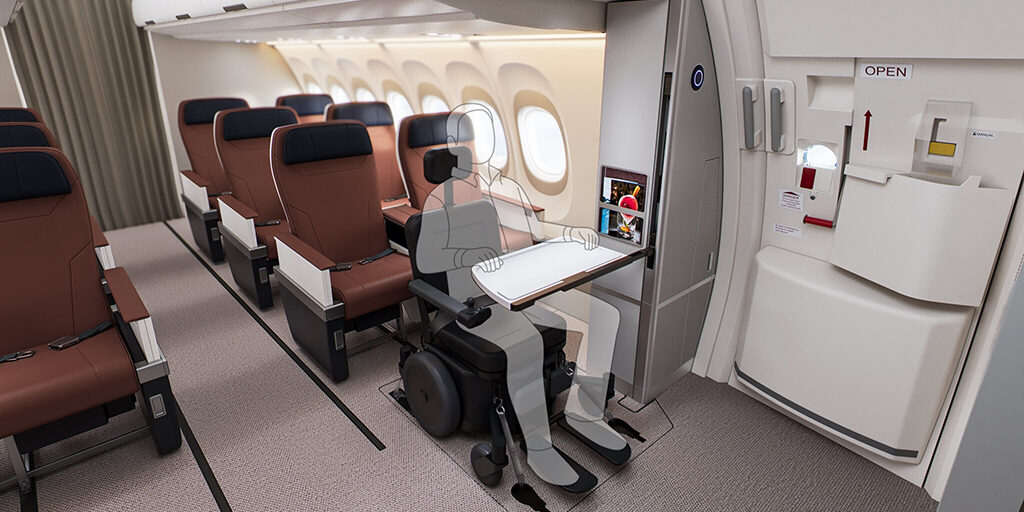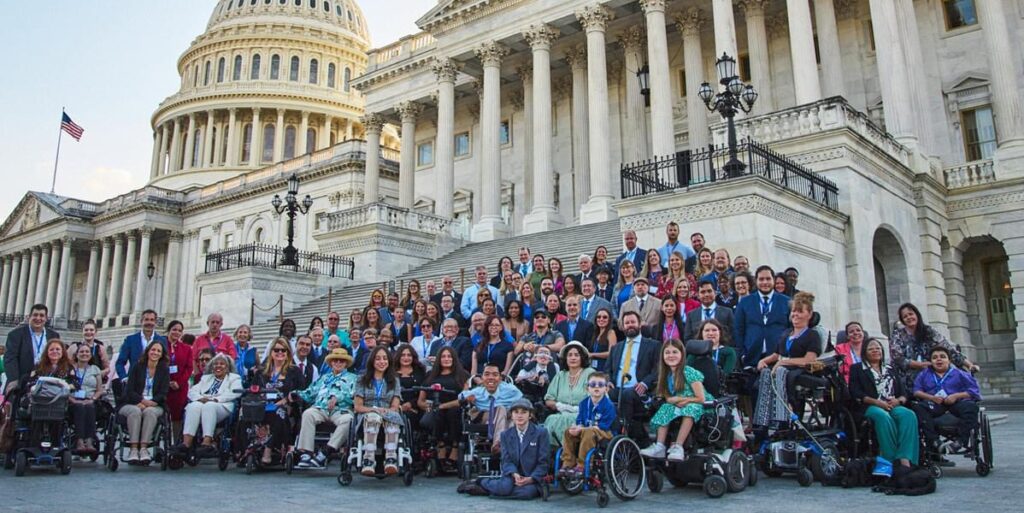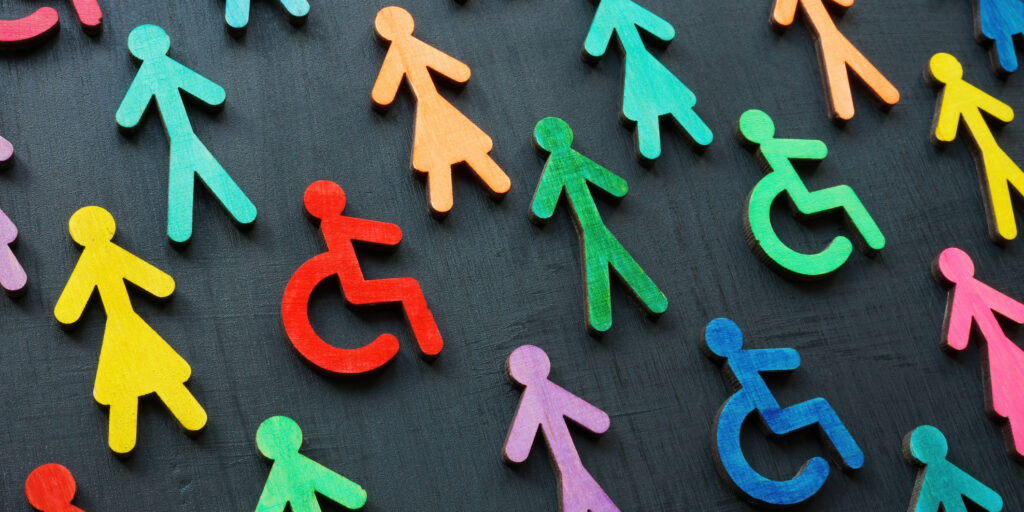
Accessible Air Travel Is Ready for Takeoff. Can It Avoid Turbulence?
By Steve Wright | Friday, May 30, 2025
5 Second Summary
Recent policy and rule changes improve protections for airline passengers with disabilities and their wheelchairs. Advocates helped bring about these reforms and are key to keeping the momentum going.
The past year featured the most disability-positive changes for air travel in decades. While there is still a way to go before air travel is fully accessible, policy and rule changes promise to make it safer and more dignified for people with disabilities.

Shannon Wood, MDA’s Director of Disability Policy
Most of the changes came in the Federal Aviation Administration (FAA) Reauthorization, an act that is reapproved every five years, most recently in May 2024.
“Senator Tammy Duckworth, a Democrat, was instrumental in getting disability provisions included. Senator Ted Cruz, a Republican, helped move the bill forward on the Senate floor — it had very strong bipartisan support,” says Shannon Wood, Director of Disability Policy at MDA. “We can say that in conjunction with disability advocates from across the disability rights community, those living with neuromuscular diseases played a huge role in getting disability-rights provisions successfully included in FAA reauthorization.”
Advocates will continue to play an essential role in ensuring that all the promised reforms are implemented without delay or reversal.
Advocacy gets results
Shannon noted that MDA advocates sent more than 400 comments to the US Department of Transportation (DOT), and many testified at listening sessions the DOT held to gather input for the final FAA reauthorization.
Disability-related provisions in the FAA reauthorization include:
- Strengthening training requirements for those assisting passengers with limited mobility, as well as for those who stow wheelchairs and assistive devices
- Improving the complaint process with the DOT
- Requiring better reporting of data on mishandled wheelchairs
- Funding continued study into in-cabin wheelchair tie-down systems
At the end of 2024, the DOT released additional disability-positive rules that went into effect in January 2025, such as:
- Codifying that airline actions that result in a “heightened risk of bodily injury, which may include loss or damage to wheelchairs and other assistive devices that result in bodily injury,” violate the rights of passengers with disabilities
- Stating that personnel and boarding chairs must be ready to assist passengers no later than when other passengers have left the aircraft
- Requiring airline workers and contractors to get enhanced training on wheelchair disassembly and reassembly, proper wheelchair loading and securement, and safe and dignified passenger transfer assistance
However, in February 2025, the trade group Airlines for America and five air carriers — American, Delta, JetBlue, Southwest, and United — filed a lawsuit, arguing that some of the DOT’s new rules regarding protections for passengers with wheelchairs are unnecessary and an overreach. As of press time, the DOT’s rules are still in effect.
Holding airlines accountable
In October 2024, the DOT showed that its commitment to safer, more inclusive air travel was more than lip service. It levied a $50 million fine against American Airlines for violating laws protecting passengers with disabilities, sending a signal to the industry that poor treatment of passengers with disabilities would not be tolerated.
The largest disability enforcement action before this fine was only $2 million. Shannon notes that while half of the fine goes to the US Treasury, the remaining $25 million will be credited to American Airlines in the form of offsets.
“Offsets could be used for investments in equipment to reduce wheelchair damage, wheelchair lifts used to safely lower wheelchairs from the jet bridge down to the tarmac, system-wide wheelchair tagging systems, or other improvements,” she says.
MDA works closely with Paralyzed Veterans of America (PVA) and other nonprofit organizations to advocate for better air travel. PVA filed formal complaints about American Airlines’ “physical assistance that at times resulted in unsafe and undignified treatment of wheelchair users.” When the fine was levied, the DOT cited PVA’s complaints that outlined egregious actions.

Heather Ansley, Chief Policy Officer for Paralyzed Veterans of America
Heather Ansley is Chief Policy Officer for PVA and the co-chair of the Air Carrier Access Act (ACAA) Advisory Committee. The 2024 FAA reauthorization extended the life of the committee and charged it with researching and advising on crucial mobility issues, such as the use of lithium batteries in assistive mobility devices and best practices for service animals in flight.
“Overall, the disability community is focused on our advocacy to make sure any administration knows that we are watching the deadlines given by Congress, and we feel strongly about action being needed,” Heather says.
Many changes that will benefit disabled passengers are still in the rulemaking stage or have longer deadlines for implementation. This means it is too early to see widespread change, and it is imperative to work with the administration and the airline industry to ensure forward momentum.
Encountering issues
“People with disabilities have the right to access any mode of transportation and have the same safe experience that everyone else has,” Heather says. “If you have to be across the country the next day — to address an urgent family matter or attend a critical business meeting — the only way you can do that is to fly. People with disabilities are no different. They’ve paid the fare, so the airline needs to provide a safe and dignified experience.”
If something happens to your wheelchair or other mobility device during air travel, document the damage or other issues in writing and take photos. The quickest way to get a response is to contact the airline. Check the airline’s website to see if they have a specific phone number to call for disability-related concerns (Find more advice from experienced travelers in MDA Ambassadors Share Tips for Flying with Power Wheelchairs and Medical Equipment.).
“If the issue is not resolved sufficiently, or if you have concerns that your rights were violated, also submit a complaint to the DOT,” Shannon says. “It’s those complaints to the DOT that led to the unprecedented fine against American Airlines last year.” (Fill out the DOT Air Travel Service Complaint or Comment Form.)
Still pushing for wheelchairs in flight

Michele Erwin, Founder and President of All Wheels Up
MDA, PVA, and other disability-related organizations agree that adjusting airplane cabins to allow travelers to remain in their wheelchairs while flying is the seismic shift needed in air travel.
For 15 years, All Wheels Up Founder and President Michele Erwin has been leading that charge. She believes airlines are starting to see that it makes economic sense.
“We know 80% of power wheelchair users do not travel by air because of the possibility of lost or damaged mobility devices,” Michele says. “There are 4 million wheelchair users in the United States and at least 20 million globally, but only a fraction are traveling. When someone travels by plane, airlines don’t just sell one ticket — they sell two to four more tickets to family members, friends, and business associates. More accessibility means more revenue.”
In addition, the FAA Reauthorization Act includes some victories for moving toward in-flight travel in an assistive mobility device:
- Congress will fund an in-depth budget impact model exploring how a wheelchair spot in the cabin impacts airlines, equipment manufacturers, tourism dollars, and damage cost avoidance.
- Testing will focus on tie-down devices that provide safe travel for wheelchair passengers.
- The FAA will conduct studies on creating evacuation plans for travelers in their own wheelchairs on board. Safety studies and evacuation plans are a core element before the airline industry can move forward.
Michele says momentum is building, evidenced by several airline equipment manufacturers visiting with her during the Aircraft Interiors Expo, the world’s largest aircraft interiors trade show. She also notes that aircraft manufacturers, such as Airbus, have been attending All Wheels Up’s conferences.
Keeping the momentum going
Just as MDA advocates were key in shaping the provisions of the FAA Reauthorization and new DOT rules, they play a significant role in telling the airline industry and lawmakers that their work is not done.
“MDA stands ready to work with all our champions to drive positive policy change for travelers affected by neuromuscular disease,” Shannon says. She encourages everyone to write to their elected officials and the DOT to keep building momentum for more inclusive and safer travel. (Search for your elected officials on MDA’s Advocacy website, or submit comments to the DOT through the Air Travel Service Complaint or Comment Form.)
“Safety and dignity for wheelchair users is a basic right, but it also opens up travel for people with disabilities, which is good for them, good for the industry, and good for business,” Michele says.
Steve Wright is an award-winning writer and advocate based in Miami. He lectures throughout the US and abroad on creating a better built environment for people with disabilities.
Know Your Rights as an Airline Passenger
Stay up-to-date on rules regarding accessible air travel and your rights with these resources.
- Find updates on air travel reforms at org/airtravel.
- Visit the US Department of Transportation’s page on Aviation Consumer Protection for people with disabilities.
- Familiarize yourself with the Airline Passengers with Disabilities Bill of Rights.
- Learn about federal policies and protections for flying with service animals.
- Learn how the Air Carrier Access Act prohibits discrimination based on disability in air travel.
- Find more details on the FAA Reauthorization Act of 2024.
Next Steps and Useful Resources
- Gain practical tips for overcoming transportation barriers and learn about laws and protections with MDA’s no-cost Access Workshop: Access to Travel and Transportation.
- Is Train Travel a Wheelchair-Friendly Alternative to Flying or Driving? Read this Quest article to find out.
- Listen to the Quest Podcast Expert Accessible Travel Tips for Your Next Vacation.
- Stay up to date on Quest content! Subscribe to Quest Magazine and Newsletter.
TAGS: Accessible Air Travel, Featured Content, Travel, Web Exclusive
TYPE: Featured Article
Disclaimer: No content on this site should ever be used as a substitute for direct medical advice from your doctor or other qualified clinician.




